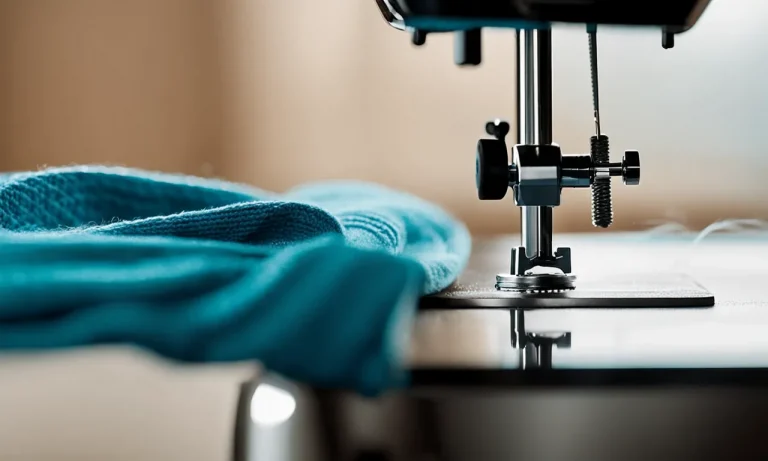Is Polyester Hotter Than Cotton? A Detailed Comparison
Staying cool and comfortable is a top priority when choosing clothes, especially during the hot summer months. If you’re trying to decide between polyester and cotton fabrics, you may be wondering: is polyester hotter than cotton?
If you’re short on time, here’s a quick answer to your question: Yes, polyester tends to be hotter than cotton. Polyester is less breathable, causing heat and sweat to build up more. Cotton is more breathable and better at wicking away sweat.
In this detailed article, we’ll compare polyester and cotton fabrics across various factors like breathability, durability, cost, and more. We’ll help you understand the advantages and disadvantages of each, so you can make the best choice for your needs.
Breathability and Temperature Regulation
Cotton is More Breathable
When it comes to breathability, cotton takes the lead. Cotton fibers are natural and porous, allowing air to flow easily through the fabric. This helps to keep the body cool and comfortable, especially in hot and humid weather.
The breathable nature of cotton makes it an excellent choice for summer clothing, as it allows sweat to evaporate quickly, preventing the buildup of moisture on the skin.
Cotton’s breathability is further enhanced by its ability to absorb moisture. As sweat is absorbed by the cotton fibers, it is drawn away from the body, keeping the skin dry and reducing the chances of discomfort or irritation.
This natural moisture-wicking property of cotton makes it a popular choice for activewear and sleepwear.
Polyester Retains More Heat
On the other hand, polyester is less breathable compared to cotton. Polyester fibers are synthetic and less porous, which restricts the flow of air through the fabric. This can lead to a buildup of heat and moisture, making polyester clothing less comfortable in hot and humid conditions.
Polyester is known for its ability to retain heat, making it a suitable choice for colder climates or winter clothing. The tightly woven fibers of polyester trap body heat, keeping the wearer warm even in chilly temperatures.
However, this heat-retaining property can also make polyester clothing feel stuffy and uncomfortable in warmer weather.
Moisture Wicking Ability
While cotton is known for its excellent moisture-wicking ability, polyester also has its own moisture management properties. Polyester fabrics are often engineered with moisture-wicking technologies, which help to pull sweat away from the body and towards the outer surface of the fabric.
This allows the moisture to evaporate quickly, keeping the wearer relatively dry and comfortable.
It’s important to note that the moisture-wicking ability of polyester can vary depending on the specific fabric construction and technologies used. Some polyester blends may offer better moisture-wicking performance compared to others.
Additionally, the effectiveness of moisture-wicking can also be influenced by factors such as humidity levels and physical activity.
Durability and Wrinkle Resistance
Cotton Wrinkles Easily
One of the major downsides of cotton is its tendency to wrinkle easily. This is because cotton fibers are natural and more prone to creasing. When cotton garments are folded or crumpled, wrinkles can form, making them look less neat and professional.
It can be frustrating to constantly iron or steam cotton clothing to maintain a wrinkle-free appearance.
Cotton’s propensity to wrinkle can be especially problematic for those who lead busy lives and don’t have much time for ironing. Imagine having to rush to get ready for work in the morning and realizing that your favorite cotton shirt is full of wrinkles.
It can be a hassle and add unnecessary stress to your day.
However, it’s important to note that not all cotton fabrics wrinkle equally. Some cotton blends or treated fabrics may have improved wrinkle resistance compared to 100% cotton. Additionally, the thickness and quality of the cotton fabric can also impact its wrinkle resistance.
Polyester Holds Its Shape Better
On the other hand, polyester is known for its excellent wrinkle resistance and ability to hold its shape. Polyester fibers are synthetic and less prone to wrinkling, making it a popular choice for garments that require a more polished and crisp appearance.
Polyester’s wrinkle-resistant properties make it ideal for travel and situations where you need to look presentable without worrying about creases. Whether you’re attending an important business meeting or going on a long flight, polyester clothing can help you maintain a professional and well-groomed look.
In addition to its wrinkle resistance, polyester also offers excellent durability. It is a strong and resilient fabric that can withstand regular wear and tear, making it a good choice for clothing that needs to withstand frequent washing and use.
Despite its wrinkle resistance and durability, some people may find polyester less comfortable to wear compared to cotton. Polyester does not have the same breathability as cotton, which can make it feel less comfortable in hot and humid weather.
Ultimately, the choice between cotton and polyester will depend on your personal preferences and priorities. If wrinkle resistance and durability are important to you, polyester may be the better option.
However, if breathability and natural fibers are your top priorities, cotton could be the way to go.
Cost and Maintenance
Cotton is Typically More Expensive
When it comes to cost, cotton tends to be more expensive than polyester. This is because cotton is a natural fiber and requires more resources to produce. The cultivation, harvesting, and processing of cotton fibers involve a series of labor-intensive steps.
Additionally, the demand for cotton often exceeds its supply, leading to higher prices in the market. On the other hand, polyester is a synthetic fiber made from petroleum, which is a cheaper resource compared to cotton. As a result, polyester fabrics are generally more affordable.
Caring for Polyester is Easier
One advantage of polyester over cotton is its ease of maintenance. Polyester fabrics are known for their durability and resistance to wrinkles, shrinking, and fading. Unlike cotton, polyester does not require special care such as ironing or dry cleaning.
Polyester can be easily machine washed and dried, making it a convenient choice for busy individuals or those who prefer low-maintenance clothing. Additionally, polyester is less prone to pilling, which is the formation of small balls of fiber on the surface of the fabric.
This means that polyester garments retain their appearance and quality for a longer period of time.
It is important to note that while polyester may be easier to care for, it does have some drawbacks. Polyester does not absorb moisture as well as cotton, which can make it less comfortable to wear in hot and humid climates.
Additionally, some people may find polyester fabrics to be less breathable compared to cotton. However, advancements in fabric technology have led to the development of moisture-wicking polyester fabrics that offer improved breathability and comfort.
Environmental Impact
Cotton Has High Water Usage
Cotton is known for its high water usage during cultivation. It takes, on average, about 2,700 liters of water to produce a single cotton t-shirt. This is due to the fact that cotton is a thirsty plant and requires a significant amount of irrigation to grow.
The excessive water usage in cotton cultivation contributes to water scarcity in many regions around the world. Additionally, the use of pesticides and fertilizers in cotton farming can contaminate nearby water sources, further exacerbating the environmental impact.
Polyester is Not Biodegradable
On the other hand, one of the major environmental concerns associated with polyester is its lack of biodegradability. Polyester is a synthetic material made from petroleum-based products. It takes hundreds of years for polyester to decompose in landfills, contributing to the growing issue of plastic pollution.
Microplastics, which are tiny particles of plastic, are released into the environment when polyester garments are washed, further polluting our oceans and harming marine life.
According to a study conducted by the University of California, synthetic microfibers like polyester make up 85% of human-made debris found on shorelines worldwide.
It’s important to note that both cotton and polyester have significant environmental impacts throughout their life cycles, from production to disposal. However, there are initiatives in place to mitigate these impacts.
Sustainable cotton farming practices, such as organic and regenerative farming, aim to reduce water usage and minimize the use of harmful chemicals. Similarly, efforts are being made to develop more sustainable alternatives to polyester, such as recycled polyester made from post-consumer plastic bottles.
For more information on sustainable fashion practices, you can visit Fashion Revolution, an organization dedicated to promoting transparency and sustainability in the fashion industry.
Ideal Uses for Each Fabric
Cotton for Breathability
Cotton is known for its breathability, making it an ideal fabric for everyday wear and warmer climates. The natural fibers of cotton allow air to circulate, keeping the body cool and comfortable. This makes cotton a great choice for summer clothing, such as t-shirts, dresses, and shorts.
Additionally, cotton is hypoallergenic and gentle on the skin, making it suitable for those with sensitive skin or allergies.
Cotton is also commonly used in bedding and home textiles. Its breathability allows for better air circulation, preventing moisture buildup and helping to regulate body temperature while sleeping. This can result in a more comfortable and restful night’s sleep.
For more information on the benefits of cotton, you can visit Cotton Incorporated, a website dedicated to promoting the use of cotton and providing information about its qualities and uses.
Polyester for Athletic Wear
Polyester is a synthetic fabric that is often used in athletic wear and performance clothing. It is known for its moisture-wicking properties, which help to keep the body dry during physical activity. Polyester fibers repel water and sweat, allowing moisture to evaporate quickly.
This makes it a popular choice for activewear, such as workout shirts, leggings, and sports bras.
Another advantage of polyester is its durability and resistance to wrinkles, shrinking, and fading. This makes it a practical choice for athletic wear that needs to withstand frequent washing and intense workouts.
It’s important to note that while polyester may not be as breathable as cotton, advancements in fabric technology have led to the development of moisture-wicking and breathable polyester blends. These blends combine the moisture-wicking properties of polyester with the breathability of natural fibers like cotton or bamboo.
For more information on the use of polyester in athletic wear, you can visit Polyester.com, a website that provides detailed information about polyester fabric and its applications in various industries.
Conclusion
When choosing between cotton and polyester clothing, consider your needs for breathability, durability, cost, and care. Cotton excels in breathability while polyester holds up better over time and resists wrinkles.
For hot weather, lightweight cottons will likely feel cooler. But polyester athletic wear wicks sweat during workouts. Evaluate both fabrics’ advantages and disadvantages for your specific circumstances.
With some compromise, you may be able to find cotton-polyester blends providing the best of both worlds. Hopefully this comparison gives you the knowledge to make the optimal choice between polyester vs. cotton for your needs.







